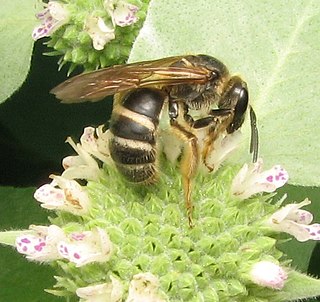
Lasioglossum zephyrum is a sweat bee of the family Halictidae, found in the U.S. and Canada. It is considered a primitively eusocial bee, although it may be facultatively solitary. The species nests in underground burrows and has been observed forcing open unbloomed flowers of species Xyris tennesseensis to extract the pollen, ensuring first and exclusive access.
Lasioglossum gotham, commonly known as the Gotham bee, is an extant species of sweat bee native to Eastern and Midwestern United States.
Homalictus singhalensis, also known as Lasioglossum (Homalictus) singhalensis, is a species of bees in the genus Homalictus, of the family Halictidae. Sometimes, genus Homalictus is placed as a subgenus within the genus Lasioglossum.
Homalictus paradnanus, also known as Lasioglossum (Homalictus) paradnanus, is a species of bees in the genus Homalictus, of the family Halictidae. Sometimes, genus Homalictus is placed as a subgenus within the genus Lasioglossum.
Lasioglossum cire, also known as the Lasioglossum (Ctenomia) cire, is a species of bees in the genus Lasioglossum, of the family Halictidae.
Lasioglossum semisculptum, also known as the Lasioglossum (Ctenomia) semisculptum, is a species of bees in the genus Lasioglossum, of the family Halictidae.
Lasioglossum vagans, also known as the Lasioglossum (Ctenomia) vagans, is a species of bee in the family Halictidae.
Lasioglossum carinifrons, also known as the Lasioglossum (Evylaeus) carinifrons, is a species of bees in the genus Lasioglossum, of the family Halictidae.

Lasioglossum halictoides, also known as the Lasioglossum (Nesohalictus) halictoides, is a species of bees in the genus Lasioglossum, of the family Halictidae.
Lasioglossum serenum, also known as the Lasioglossum (Nesohalictus) serenum, is a species of bees in the genus Lasioglossum, of the family Halictidae.
Lasioglossum alphenum, also known as the Lasioglossum (Sudila) alphenum by Sakagami et al. (1996), is a species of bees in the genus Lasioglossum, of the family Halictidae.
Lasioglossum bidentatum, also known as the Lasioglossum (Sudila) bidentatum, is a species of bee in the genus Lasioglossum, of the family Halictidae. The species is mispellingly known as specific name bidendatum in some books.

Lasioglossum cressonii is a species in the sweat bee genus Lasioglossum, family Halictidae. Halictidae exhibit eusocial hierarchy behavior which is interesting given that eusociality in this group is hard to evolve and easy to lose. L. cressonii is found throughout North America. L. cressonii have been shown to be important pollinators for apple trees and many other North American native plants.

Lasioglossum leucozonium, also known as Lasioglossum similis, is a widespread solitary sweat bee found in North America, Europe, Asia, and parts of northern Africa. While now a common bee in North America, population genetic analysis has shown that it is actually an introduced species in this region. This population was most likely founded by a single female bee.

Dialictus is a subgenus of sweat bees belonging to the genus Lasioglossum. Most of the members of this subgenus have a metallic appearance, while some are non-metallic. There are over 630 species worldwide. They are commonly found in the Northern Hemisphere and are found in abundance in North America. Members of this subgenus also have very diverse forms of social structure making them model organisms for studying the social behavior of bees.

Homalictus is a subgenus of bees in the genus Lasioglossum subfamily Halictinae of the family Halictidae. They are found in Sri Lanka, Southeast Asia, east across the Pacific to the Mariana Islands, Samoa and are most prevalent in Australia.








